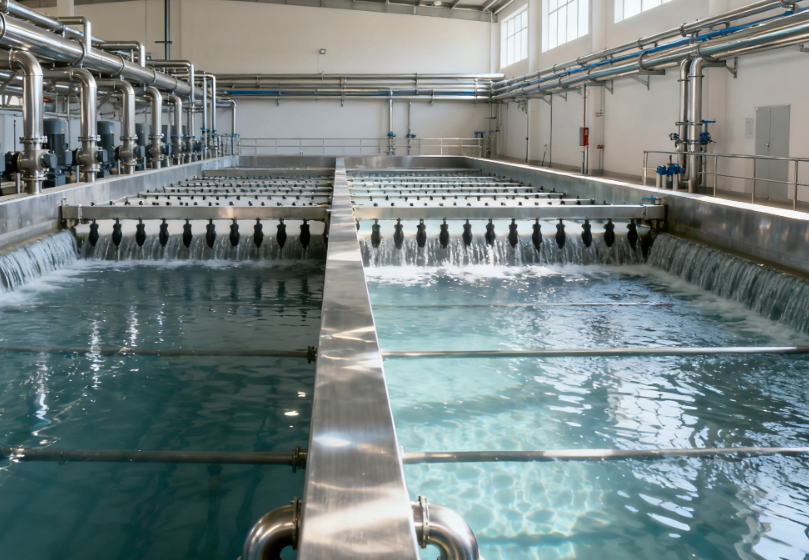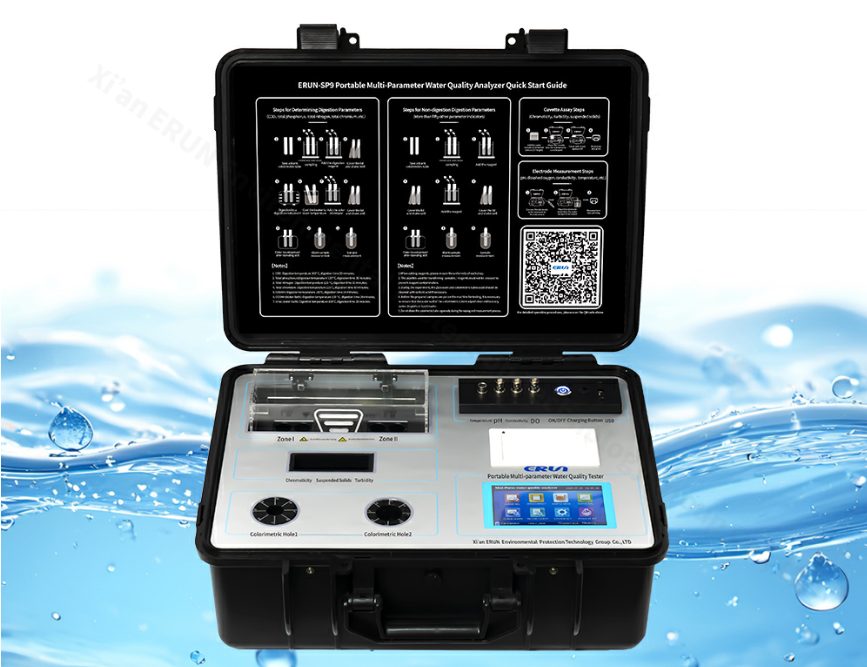Heavy metals in water, such as zinc (Zn), copper (Cu), nickel (Ni), chromium (Cr), and ammonium, pose serious risks to human health and aquatic ecosystems. Prolonged exposure, even at low concentrations, can lead to organ damage, neurological disorders, and environmental contamination. For industries, municipalities, and researchers, monitoring heavy metals is essential to ensure compliance with safety standards and protect public health.
Regular testing not only helps detect contamination early but also guides treatment strategies for drinking water, industrial effluent, and surface water. This article explores the importance of testing for heavy metals in water, common detection methods, and introduces a practical solution with the ERUN-SP9 portable multi-parameter water quality detector.
Heavy metals like zinc, copper, nickel, chromium, lead, cadmium, and mercury can enter water systems through industrial discharge, mining, agriculture, or aging infrastructure.
Long-term exposure can lead to kidney and liver damage, neurological issues, and developmental problems in children. Aquatic life is also affected, with metals accumulating in fish and entering the food chain.
Authorities such as the WHO and the EPA set strict limits for metals in drinking water. Exceeding these thresholds can trigger legal actions, environmental fines, and public health emergencies.
Traditional methods include atomic absorption spectroscopy (AAS), inductively coupled plasma (ICP), and colorimetric assays. These methods are accurate but often require complex sample preparation, expensive equipment, and skilled personnel.
Portable test kits and multi-parameter devices allow for on-site monitoring, providing quick readings for key metal ions. Although slightly less precise than laboratory methods, these devices are crucial for rapid decision-making and routine monitoring.
Lab-based testing provides high accuracy, but delays in reporting can be risky. Conversely, field devices must balance portability, speed, and detection range, particularly for metals like Zn, Cu, Ni, Cr, and ammonium.

Consistent monitoring helps:
Detect contamination early, preventing public exposure.
Ensure compliance with local and international standards.
Guide water treatment strategies, including filtration, chemical treatment, or reverse osmosis.
Protect ecosystems, minimizing bioaccumulation in aquatic organisms.
Heavy metals can accumulate over time, making single-point testing insufficient. Regular, multi-parameter monitoring is the most effective way to safeguard both human health and the environment.
Monitoring heavy metals in water is crucial for both environmental and human health. The ERUN-SP9 portable multi-parameter water quality detector is specifically designed to meet this need. It adopts an advanced 16-channel optical method, enabling detection of over 60 water quality parameters, including key metal ions such as Zn, Cu, Ni, Cr, and ammonium. Combined with electrode-based measurements for pH, conductivity, TDS, salinity, dissolved oxygen, and temperature, it provides comprehensive water quality data in one device.
The ERUN-SP9 supports customizable parameter configurations, allowing users to tailor the testing to their specific requirements, whether it’s for municipal water, industrial effluent, aquaculture, or environmental monitoring. Its high accuracy and portability make it suitable for both laboratory and field applications, ensuring timely detection of metal contaminants and reducing long-term environmental and health risks.
This device is particularly valuable for water treatment plants, environmental monitoring units, industrial self-inspections, and research institutions, providing reliable, real-time data that can guide corrective measures immediately.

Comprehensive Testing: Detects multiple metals and other key water quality parameters simultaneously.
Customizable Parameters: Configure testing items based on the specific water source or industry.
Portability and Field-Use: Equipped with a long-life battery and rugged design, ideal for on-site measurements.
Time and Cost Efficiency: Reduces dependence on laboratory testing for routine monitoring.
Accurate Data: Advanced optical and electrode methods ensure precise detection of metals and other indicators.
Regular Sampling: Collect samples consistently to track trends.
Use Calibrated Equipment: Ensure detectors like ERUN-SP9 are properly calibrated for reliable results.
Record and Analyze Data: Maintain logs to identify gradual contamination.
Follow Safety Guidelines: Proper handling of samples and reagents prevents exposure.
Combine Field and Lab Tests: Validate on-site readings with occasional lab analysis for critical applications.
Heavy metals in water can pose serious risks if left undetected. Regular testing using advanced devices like the ERUN-SP9 ensures timely detection and mitigation of contaminants such as Zn, Cu, Ni, Cr, and ammonium. By combining multi-parameter optical and electrode methods, ERUN-SP9 delivers accurate, reliable data for laboratories, industrial sites, and environmental monitoring teams. Protect your water quality and ensure safety—invest in reliable monitoring today.